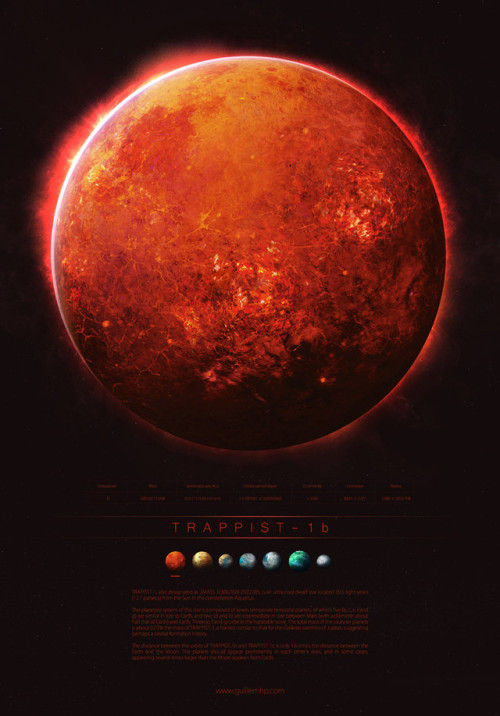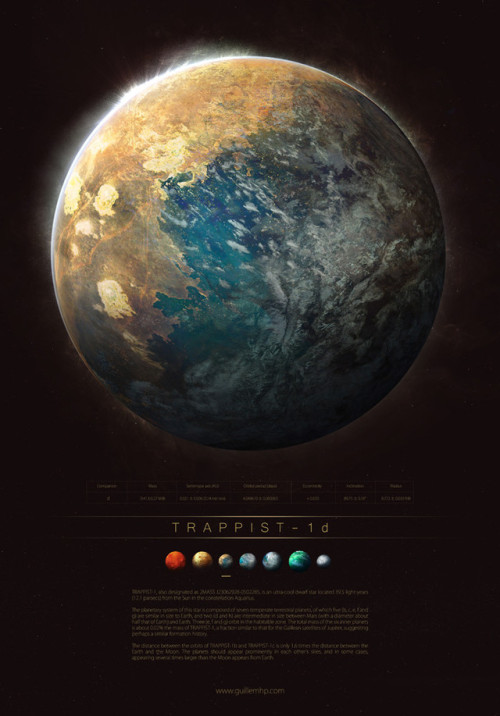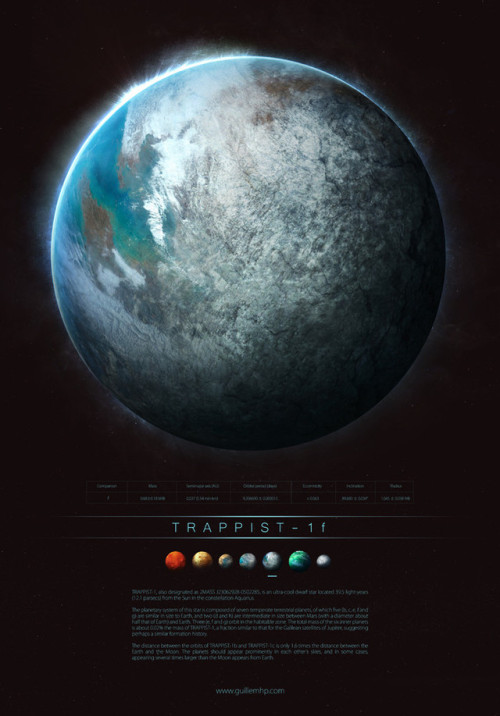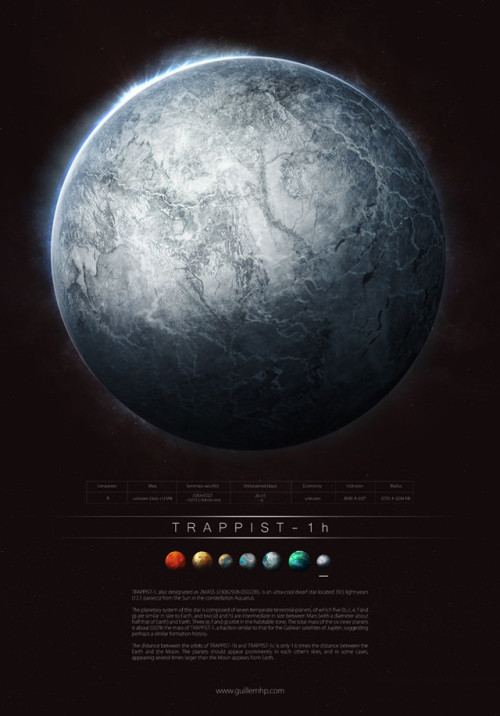Evaporating Planets
Evaporating Planets

Picture of the Day - October 27, 2018
These three planets (not comets) close to a white giant star losing their atmospheres. The giant star has expanded so fast that all of the inner planets are superheated to nearly 2,000 F.
More Posts from Sharkspaceengine and Others





Pictures of the Day December 1, 2018
Insight System - Insight B-II
The second planet orbiting Insight B. This world is a more extreme version of Venus that is choked in a thick carbon dioxide atmosphere 427 times thicker than Earths. Unlike Venus, the atmosphere is humid, water vapor comprises 6.45% of the planet’s atmosphere, further amplifying the greenhouse effect of the atmosphere.
Insight B-II is a super earth with approximately 5.28 Earth’s masses, and a radius of 1.39 Earth Radii. The planet is quite dense and has a surface gravity of 2.7 g. Such a high surface gravity flattens the ground and results in only small elevation changes across the entire surface of the planet. The planet is tidally locked to the sun and orbiting at a distance of 0.09 AU. Surface temperatures average 1,182 F. Most of the surface consists of broad plains covered in shallow sand dunes.
High Resolution Pictures
Insight B-II
Approaching the atmosphere
Storms
Daytime sky
Twilight sky







Pictures of the day 2 - December 2, 2018
Insight System - Fourth Planet (Insight B-IV)
Insight B-IV is a Saturn-Like planet with an extensive tan-colored ring system. The planet is 53,870 kilometers in radius and has a mass of 62.7 Earth’s. This small gas giant orbits Insight B at an average distance of 0.56 AU and completes and orbit once every 184.9 Earth days. A day on the planet lasts 16 hours and 24 minutes.
Weather on the planet is quite active with numerous storm systems ranging across the planet constantly. The temperatures averages -94 F.
A total of 26 moons orbit Insight B-IV, but only one of those, the third satellite is a large rounded object. Its lone large moon has a radius of 1,132 kilometers, and a mass one quarter that of our moon.
High Resolution Pictures
Insight B-IV
Active atmosphere
Lonely moon
Duality
Insight B-IV-M3 (only large moon)
Lunar Surface
Between the rings


Pictures of the Day - February 12, 2019 (Late Post)
Stormy atmosphere of a gas giant. The planet orbits a binary pair of stars consisting of a white F-Type star and a bright blue B-type star
Why Won’t Our Parker Solar Probe Melt?
This summer, our Parker Solar Probe will launch to travel closer to the Sun than any mission before it, right into the Sun’s outer atmosphere, the corona.

The environment in the corona is unimaginably hot: The spacecraft will travel through material with temperatures greater than 3 million degrees Fahrenheit.
So…why won’t it melt?
The Difference Between Heat and Temperature
Parker Solar Probe was designed from the ground up to keep its instruments safe and cool, but the nature of the corona itself also helps. The key lies in the difference between heat and temperature.
Temperature measures how fast particles are moving, while heat is the total amount of energy that they transfer. The corona is an incredibly thin and tenuous part of the Sun, and there are very few particles there to transfer energy – so while the particles are moving fast (high temperature), they don’t actually transfer much energy to the spacecraft (low heat).

It’s like the difference between putting your hand in a hot oven versus putting it in a pot of boiling water (don’t try this at home!). In the air of the oven, your hand doesn’t get nearly as hot as it would in the much denser water of the boiling pot.
So even though Parker Solar Probe travels through a region with temperatures of several million degrees, the surface of its heat shield will reach only about 2,500 F.

The Heat Shield
Of course, thousands of degrees Fahrenheit is still way too hot for scientific instruments. (For comparison, lava from volcano eruptions can be anywhere between 1,300 to 2,200 F.)
To withstand that heat, Parker Solar Probe is outfitted with a cutting-edge heat shield, called the Thermal Protection System. This heat shield is made of a carbon composite foam sandwiched between two carbon plates. The Sun-facing side is covered with a specially-developed white ceramic coating, applied as a plasma spray, to reflect as much heat as possible.

The heat shield is so good at its job that even though the Sun-facing side of the shield will be at 2,500 F, the instruments in its shadow will remain at a balmy 85 F.
Parker Solar Probe Keeps its Cool
Several other designs on the spacecraft help Parker Solar Probe beat the heat.
Parker Solar Probe is not only studying the Sun – it’s also powered by it. But even though most of the surface area of its solar arrays can be retracted behind the heat shield, even that small exposed segment would quickly make them overheat while at the Sun.

To keep things cool, Parker Solar Probe circulates a single gallon of water through its solar arrays. The water absorbs heat as it passes behind the arrays, then radiates that heat out into space as it flows into the spacecraft’s radiator.
It’s also important for Parker Solar Probe to be able to think on its feet, since it takes about eight minutes for information to travel between Earth and the Sun. If we had to control the spacecraft from Earth, by the time we knew something went wrong, it would be too late to fix it.
So Parker Solar Probe is smart: Along the edges of the heat shield’s shadow are seven sensors. If any of these sensors detect sunlight, they alert the central computer and the spacecraft can correct its position to keep the sensors – and the rest of the instruments – safely protected behind the heat shield.

Over the course of its seven-year mission, Parker Solar Probe will make 24 orbits of our star. On each close approach to the Sun, it will sample the solar wind, study the Sun’s corona, and provide unprecedentedly close up observations from around our star – and armed with its slew of innovative technologies, we know it will keep its cool the whole time.
Parker Solar Probe launches summer 2018 on its mission to study the Sun. Keep up with the latest on the mission at nasa.gov/solarprobe or follow us on Twitter and Facebook.
Make sure to follow us on Tumblr for your regular dose of space: http://nasa.tumblr.com

Picture of the Day - December 30, 2018
Globular cluster. Almost 10,000 stars packed into a sphere just 100 light years across.


Pictures of the Day - February 8, 2019 - (Late Post)
Weird red-tinted ice giant orbiting Bernard's Star viewed from the surface of several of it's asteroid moons.

Picture of the day - November 21, 2018
Small asteroid moon orbiting a gas giant.
My Space Engine Adventures, also any space related topic or news. www.spaceengine.org to download space engine. The game is free by the way. Please feel free to ask me anything, provide suggestions on systems to visit or post any space related topic.Check out my other blog https://bunsandsharks.tumblr.com for rabbit and shark blog.
294 posts









